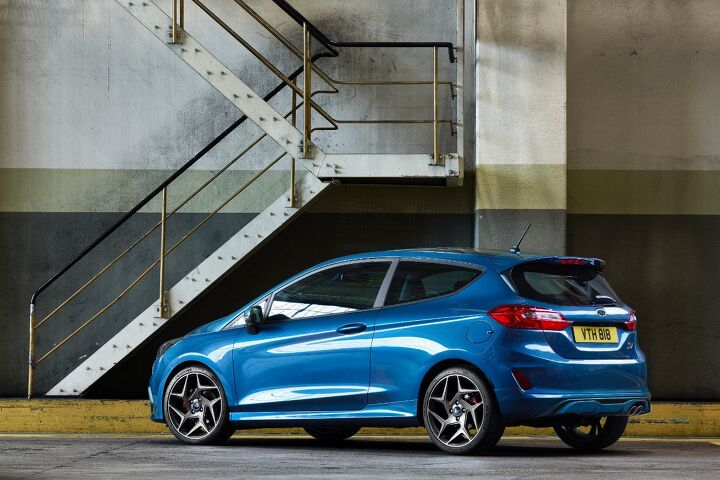Put Those Next-Gen Ford Fiesta ST Dreams to Bed, America - It's Not Happening
Over the last seven years, America, you didn’t buy many Ford Fiestas. Fewer than 430,000, in fact. For perspective, in the much smaller United Kingdom market, Ford sold over 500,000 Fiestas in just the last four years.
But the Fiesta’s lack of popularity — and its dramatic loss of popularity in America — is not a unique-to-Ford situation. U.S. sales of subcompact cars plunged by more than a fifth, year-over-year, during the first eight months of 2017. That tumble comes after U.S. sales of subcompact cars declined in 2015 and 2016, as well.
Nevertheless, it comes as no surprise that Ford, after exploring America’s affordable avenues for one generation of Fiesta, isn’t bringing the seventh-generation version to America. And now we have confirmation that there is absolutely no hope the next-gen Ford Fiesta ST will come stateside, either.
It was a pie-in-the-sky idea to begin with, based on Ford’s desire to parlay its highly regarded performance models into a broader reputation for building fun cars.
“It’s simply a matter of a lack of interest in the B-segment in America,” Leo Roeks tells CarBuzz. Roeks is Ford’s director of performance in Europe. “It doesn’t make sense, nor is it possible financially speaking, to import a single trim level, and a niche one at that.”
Making matters worse, the next-gen Ford Fiesta ST is quite likely going to be even better than the departing model: more powerful, more comfortable, more efficient, arguably more attractive, more driving modes. TTAC was an unabashed fan of the 2014-2017 Fiesta ST, a rare car that Ford initially hoped to sell at a rate of roughly 10,000 per year in the U.S.. (Ford sells roughly 16,000 F-Series pickups per week in America.) In fact, you’ll find a Fiesta ST in our long-term reports, where cars are paid for with our own real money. Moreover, there’s another Fiesta long-termer that was paid for by TTAC’s former managing editor.
But that’ll be the end. As Ford’s Leo Roeks says, America’s lack of interest in the subcompact segment is obvious, and investing in that segment must be done purely on the basis of grabbing consumers at the earliest point. Some automakers believe that’s essential. But it’s a long-term approach deemed unnecessary by others.
The good news? According to Cars.com, there are still more than 1,000 new Ford Fiesta STs in stock at dealers across America. Get one while you still can.
No, seriously. Go get one.
[Image: Ford Europe]
Timothy Cain is a contributing analyst at The Truth About Cars and Autofocus.ca and the founder and former editor of GoodCarBadCar.net. Follow on Twitter @timcaincars and Instagram.
More by Timothy Cain
Latest Car Reviews
Read moreLatest Product Reviews
Read moreRecent Comments
- TheEndlessEnigma These cars were bought and hooned. This is a bomb waiting to go off in an owner's driveway.
- Kwik_Shift_Pro4X Thankfully I don't have to deal with GDI issues in my Frontier. These cleaners should do well for me if I win.
- Theflyersfan Serious answer time...Honda used to stand for excellence in auto engineering. Their first main claim to fame was the CVCC (we don't need a catalytic converter!) engine and it sent from there. Their suspensions, their VTEC engines, slick manual transmissions, even a stowing minivan seat, all theirs. But I think they've been coasting a bit lately. Yes, the Civic Type-R has a powerful small engine, but the Honda of old would have found a way to get more revs out of it and make it feel like an i-VTEC engine of old instead of any old turbo engine that can be found in a multitude of performance small cars. Their 1.5L turbo-4...well...have they ever figured out the oil dilution problems? Very un-Honda-like. Paint issues that still linger. Cheaper feeling interior trim. All things that fly in the face of what Honda once was. The only thing that they seem to have kept have been the sales staff that treat you with utter contempt for daring to walk into their inner sanctum and wanting a deal on something that isn't a bare-bones CR-V. So Honda, beat the rest of your Japanese and Korean rivals, and plug-in hybridize everything. If you want a relatively (in an engineering way) easy way to get ahead of the curve, raise the CAFE score, and have a major point to advertise, and be able to sell to those who can't plug in easily, sell them on something that will get, for example, 35% better mileage, plug in when you get a chance, and drives like a Honda. Bring back some of the engineering skills that Honda once stood for. And then start introducing a portfolio of EVs once people are more comfortable with the idea of plugging in. People seeing that they can easily use an EV for their daily errands with the gas engine never starting will eventually sell them on a future EV because that range anxiety will be lessened. The all EV leap is still a bridge too far, especially as recent sales numbers have shown. Baby steps. That's how you win people over.
- Theflyersfan If this saves (or delays) an expensive carbon brushing off of the valves down the road, I'll take a case. I understand that can be a very expensive bit of scheduled maintenance.
- Zipper69 A Mini should have 2 doors and 4 cylinders and tires the size of dinner plates.All else is puffery.



































Comments
Join the conversation
Well, I figure this can only help the value of my 2014 FiST. Plan to hang onto it for a few years, keep it clean, and I expect there will be some demand.
Have Lincoln import is as a "BFX" or something! See if the buyers will pay for higher import costs?!?